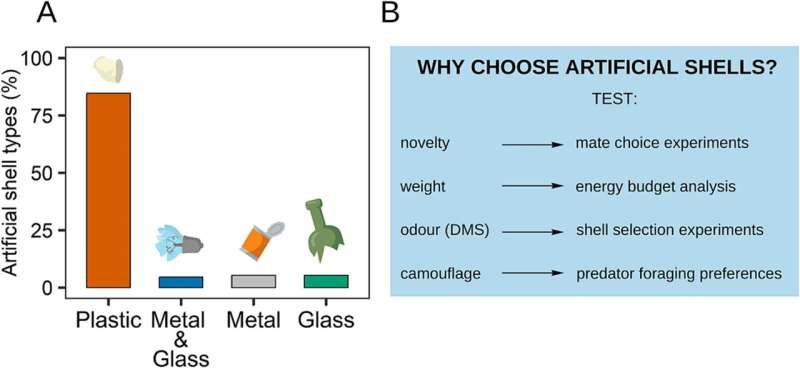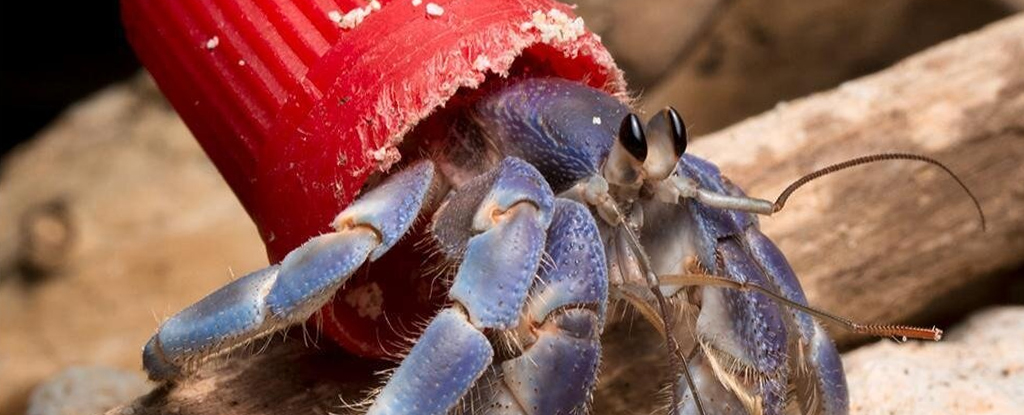Products You May Like
Land hermit crabs have been using bottle tops, parts of old light bulbs and broken glass bottles, instead of shells.
New research by Polish researchers studied 386 images of hermit crabs occupying these artificial shells. The photos had been uploaded by users to online platforms, then analyzed by scientists using a research approach known as iEcology.
Of the 386 photos, the vast majority, 326 cases, featured hermit crabs using plastic items as shelters.
At first glance, this is a striking example of how human activities can alter the behavior of wild animals, and potentially the ways that populations and ecosystems function as a result.
But there are lots of factors at play and, while it’s easy to jump to conclusions, it’s important to consider exactly what might be driving this particular change.
Shell selection
Hermit crabs are an excellent model organism to study because they behave in many different ways and those differences can be easily measured.
Instead of continuously growing their own shell to protect their body, like a normal crab or a lobster would, they use empty shells left behind by dead snails. As they walk around, the shell protects their soft abdomen but whenever they are threatened they retract their whole body into the shell. Their shells act as portable shelters.
Having a good enough shell is critical to an individual’s survival so they acquire and upgrade their shells as they grow. They fight other hermit crabs for shells and assess any new shells that they might find for suitability.
Primarily, they look for shells that are large enough to protect them, but their decision-making also takes into account the type of snail shell, its condition and even its color – a factor that could impact how conspicuous the crab might be.
Another factor that constrains shell choice is the actual availability of suitable shells. For some as yet unknown reason, a proportion of land hermit crabs are choosing to occupy plastic items rather than natural shells, as highlighted by this latest study.

Housing crisis or ingenious new move?
Humans have intentionally changed the behavior of animals for millennia, through the process of domestication. Any unintended behavioral changes in natural animal populations are potentially concerning, but how worried should we be about hermit crabs using plastic litter as shelter?
The Polish research raises a number of questions. First, how prevalent is the adoption of plastic litter instead of shells?
While 326 crabs using plastic seems like a lot, this is likely to be an underestimation of the raw number given that users are likely to encounter crabs only in accessible parts of the populations.
Conversely, it seems probable that users could be biased towards uploading striking or unusual images, so the iEcology approach might produce an exaggerated impression of the proportion of individuals in a population opting for plastic over natural shells. We need structured field surveys to clarify this.
Second, why are some individual crabs using plastic?
One possibility is that they are forced to due to a lack of natural shells, but we can’t test this hypothesis without more information on the demographics of local snail populations.
Or perhaps the crabs prefer plastic or find it easier to locate, compared with real shells?
As the authors point out, plastic might be lighter than the equivalent shells affording the same amount of protection but at lower energy cost of carrying them. Intriguingly, chemicals that leach out of plastic are known to attract marine hermit crabs by mimicking the odor of food.
This leads to a third question about the possible downsides of using plastic. Compared to real shells plastic waste tends to be brighter and might contrast more with the background making the crabs more vulnerable to predators.
Additionally, we know that exposure to microplastics and compounds that leach from plastic can change the behavior of hermit crabs, making them less fussy about the shells that they choose, less adept at fighting for shells and even changing their personalities by making them more prone to take risks. To answer these questions about the causes and consequences of hermit crabs using plastic waste in this way, we need to investigate their shell selection behavior through a series of laboratory experiments.

Pollution changes behavior
Plastic pollution is just one of the ways we are changing our environment. It’s by far the most highly reported form of debris that we have introduced to marine environments. But animal behavior is affected by other forms of pollution too, including microplastics, pharmaceuticals, light and noise, plus the rising temperatures and ocean acidification caused by climate change.
So while investigating the use of plastic waste by hermit crabs could help us better understand the consequences of certain human impacts on the environment, it doesn’t show how exactly animals will adjust to the Anthropocene, the era during which human activity has been having a significant impact on the planet. Will they cope by using plastic behavioral responses or evolve across generations, or perhaps both?
In my view, the iEcology approach cannot answer questions like this. Rather, this study acts as an alarm bell highlighting potential changes that now need to be fully investigated.
Mark Briffa, Professor of Animal Behavior, University of Plymouth
This article is republished from The Conversation under a Creative Commons license. Read the original article.
